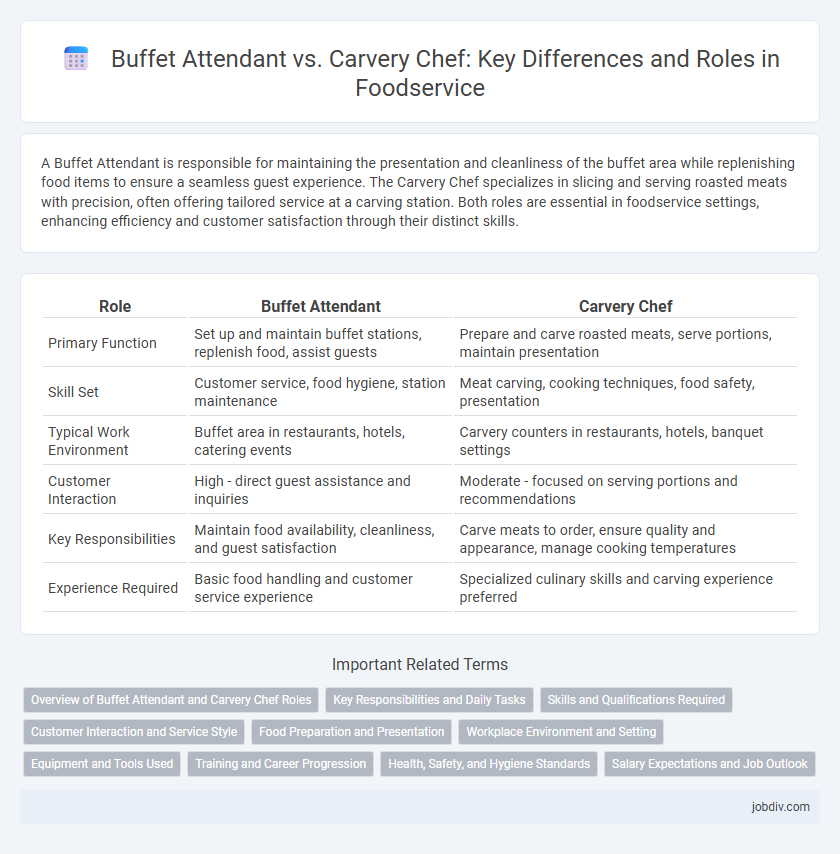A Buffet Attendant is responsible for maintaining the presentation and cleanliness of the buffet area while replenishing food items to ensure a seamless guest experience. The Carvery Chef specializes in slicing and serving roasted meats with precision, often offering tailored service at a carving station. Both roles are essential in foodservice settings, enhancing efficiency and customer satisfaction through their distinct skills.
Table of Comparison
| Role | Buffet Attendant | Carvery Chef |
|---|---|---|
| Primary Function | Set up and maintain buffet stations, replenish food, assist guests | Prepare and carve roasted meats, serve portions, maintain presentation |
| Skill Set | Customer service, food hygiene, station maintenance | Meat carving, cooking techniques, food safety, presentation |
| Typical Work Environment | Buffet area in restaurants, hotels, catering events | Carvery counters in restaurants, hotels, banquet settings |
| Customer Interaction | High - direct guest assistance and inquiries | Moderate - focused on serving portions and recommendations |
| Key Responsibilities | Maintain food availability, cleanliness, and guest satisfaction | Carve meats to order, ensure quality and appearance, manage cooking temperatures |
| Experience Required | Basic food handling and customer service experience | Specialized culinary skills and carving experience preferred |
Overview of Buffet Attendant and Carvery Chef Roles
Buffet attendants manage food presentation, replenish dishes, and maintain cleanliness to ensure a seamless guest experience in buffet settings. Carvery chefs specialize in preparing and carving roasted meats, delivering expertly sliced portions with precision and skill at carving stations. Both roles demand strong customer service skills and food safety knowledge but differ in their focus on food preparation versus buffet management.
Key Responsibilities and Daily Tasks
Buffet Attendants manage the presentation, replenishment, and cleanliness of buffet stations, ensuring food safety standards and customer satisfaction throughout service hours. Carvery Chefs specialize in preparing, carving, and displaying roasted meats, maintaining precise portion control, and assisting guests with meat selections. Both roles require constant attention to hygiene, efficient time management, and excellent customer interaction skills within high-volume foodservice environments.
Skills and Qualifications Required
Buffet attendants require strong customer service skills, attention to detail, and the ability to maintain cleanliness and presentation standards in a fast-paced environment. Carvery chefs need advanced culinary skills, expertise in meat carving techniques, and the ability to prepare and cook large cuts of meat to precise specifications. Both roles typically demand food safety certification and experience in a foodservice setting, but carvery chefs often require formal culinary training or apprenticeship.
Customer Interaction and Service Style
Buffet Attendants maintain a self-service environment, assisting customers with replenishing food items and ensuring cleanliness, fostering a casual and efficient interaction. Carvery Chefs engage directly with guests by carving meats to order, offering personalized service and enhancing the dining experience through tailored portions and recommendations. The distinct service styles impact customer satisfaction, with Buffet Attendants supporting convenience and Carvery Chefs emphasizing customized culinary engagement.
Food Preparation and Presentation
Buffet Attendants specialize in arranging a variety of pre-prepared dishes, ensuring consistent presentation and replenishing buffet stations efficiently to maintain food quality and visual appeal. Carvery Chefs focus on skillfully carving and plating meats freshly cooked on-site, emphasizing precise portion control and visually appealing servings to enhance guest experience. Both roles require strong attention to detail in food hygiene standards and presentation aesthetics to meet foodservice industry expectations.
Workplace Environment and Setting
Buffet Attendants typically work in fast-paced, self-service dining areas where they maintain food displays, replenish items, and ensure cleanliness, often interacting directly with guests. Carvery Chefs operate in a more specialized setting, usually behind a carving station, preparing and serving freshly sliced roasts with a focus on presentation and portion control. Both roles demand adaptability in high-traffic environments but differ in the level of culinary skill and guest engagement required.
Equipment and Tools Used
Buffet Attendants primarily use serving utensils such as tongs, ladles, and trays to efficiently manage food presentation and replenishment in self-service areas. Carvery Chefs rely on specialized equipment including carving knives, electric slicers, and heat lamps to expertly slice and serve meats while keeping them warm. Both roles require hygienic gloves and sanitizing supplies to maintain food safety standards in a fast-paced foodservice environment.
Training and Career Progression
Buffet attendants typically require foundational training in food safety, customer service, and basic presentation skills, while carvery chefs need advanced culinary expertise, carving techniques, and menu development knowledge. Career progression for buffet attendants often leads to supervisory roles within hospitality settings, whereas carvery chefs can advance to senior chef positions or specialize in meat preparation and kitchen management. Continuous professional development and certification in food hygiene are crucial for both roles to enhance career opportunities in the foodservice industry.
Health, Safety, and Hygiene Standards
Buffet attendants maintain strict health, safety, and hygiene standards by regularly sanitizing serving areas and monitoring food temperatures to prevent contamination and foodborne illnesses. Carvery chefs prioritize hygiene through proper handling and carving techniques, use of separate utensils, and ensuring cooked meat reaches safe internal temperatures to minimize bacterial risks. Both roles adhere to food safety protocols, but carvery chefs require specialized training in meat preparation and knife safety to comply with occupational health regulations.
Salary Expectations and Job Outlook
Buffet attendants typically earn an average hourly wage ranging from $10 to $15, reflecting the entry-level nature of the role in the foodservice industry, while carvery chefs command higher salaries, often between $25,000 and $40,000 annually, due to specialized culinary skills. Job outlook for buffet attendants remains steady with entry-level demand in hotels and catering services, whereas carvery chefs benefit from niche expertise, leading to stronger growth prospects in upscale dining and event venues. Salary expectations correlate with experience and location, with metropolitan areas offering higher remuneration for carvery chefs compared to buffet attendants primarily employed in casual dining settings.
Buffet Attendant vs Carvery Chef Infographic

 jobdiv.com
jobdiv.com